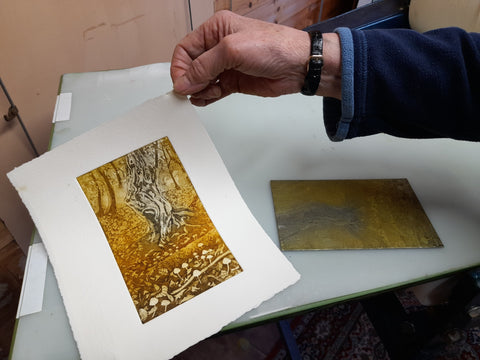Claire Longley’s work as a printer begins quite simply, but then it gets rather complicated! She loves to observe nature – to watch the blue tits in the bird bath outside her window, to admire the trees as she explores the countryside around her home. This inspires her to make a pencil drawing which is the first stage in her making an etching.
A zinc plate is covered with a waxy surface which she draws into using a sharp tool, whilst making sure that she doesn’t cut into the plate. “You dip the plate in acid, or I use copper sulphate, which eats into the plate,” says Claire. “Then I rub the waxy surface off and ink is wiped across the plate, goes into the lines and the excess ink is wiped away. The plate then goes through the press, the ink is squeezed out and a line is printed on the paper.”

So far, so relatively straightforward, but there can be a lot more stages than this. “Later, another layer, called aquatint is added,” she says, “and then stop-out which is a waxy paste you put on to stop out the parts of the print you want to stay white. You keep building it up and I generally do about seven dips. It can be quite complicated process and you need to be patient. But it is also pretty flexible and you can combine with other methods. I just love the whole process.”

Claire has always loved creating pictures and studied art as a young person, but then when she became a parent with young children there wasn’t really time. Later she discovered Seal Chart Etching Studio (www.sealchartetchingstudio.art), learned how do etching and has been doing it ever since.
She is now one of the longest-standing members of the Artspring Gallery and plays a key role in the running of the gallery. “I’ve loved it, it’s been great fun,” she says, “you meet such interesting people.”

This framed print by Claire is now for sale in the gallery.
See more of Claire's work in ArtSpring

